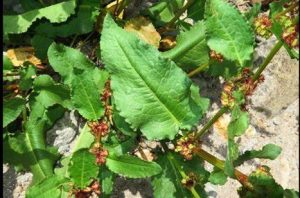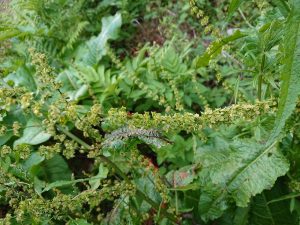Nepal Dock (Rumex nepalensis)

Rumex nepalensis, commonly known as Nepal dock or Himalayan dock, is an annual plant of the Polygonaceae family. It is native to the Himalayas and it is a tropical plant found in moist meadows, marshes, and lake shores around the world. Nepal Dock is a traditional medicinal plant with wide-spectrum therapeutic properties.
According to research from the National Centre For Biotechnology Information(NCBI) websites conducted in 2015, “R. nepalensis has high CP content under all cutting intervals but seven weeks interval provides high dry matter yield. High CP, low fibre and P content except Ca qualify R. nepalensis to be graded as a prime feed and a potential source of protein”
Health Benefits of Nepal Dock (Rumex nepalensis)
Nepal Dock is a tropical herb with immense medicinal importance. Let’s explore its fascinating properties:
-
- Purgative Properties:
- The root of R. nepalensis acts as a purgative, aiding in bowel movement.
- Traditionally, it has been used to treat constipation and dysentery.
- Wound Healing:
- A strong decoction of the root is applied to dislocated bones.
- The paste made from the root is used for swollen gums.
- Colic Treatment:
- The leaves of R. nepalensis are employed in the treatment of colic.
- Fresh leaves may provide relief from colic-related discomfort.
- Other Uses:
- The juice of the leaves is externally applied to relieve headaches.
- In some regions, R. nepalensis serves as a substitute for rhubarb.
- It has been explored for its antioxidant, antimicrobial, and anti-plasmodial activities
- in hepatitis herbal treatment
Pharmacological Activities:
- Anti-Inflammatory: R. nepalensis exhibits anti-inflammatory properties.
- Antioxidant: It is a rich source of natural antioxidants.
- Antibacterial and Antifungal: Effective against microbial pathogens.
- Antiviral: May have antiviral activity.
- Purgative: Supports digestive health.
- Analgesic and Antipyretic: Helps manage pain and fever.
- Wound Healing: May aid in wound recovery.
- Skeletal Muscle Relaxant: Provides muscle relaxation.
- Central Nervous System Depressant: Has calming effects.
- Genotoxic: Requires further study.
- Anti-Algal: Acts against algae.
- Purgative Properties:
The Chemical Properties of Nepal Dock (Rumex nepalensis)

a tropical herb with immense medicinal importance. Let’s delve into its fascinating chemical properties:
- Phytochemical Constituents:
- Rumex nepalensis contains various bioactive compounds, including:
- Emodin
- Endocrocin
- Chrysophanol
- Neopodin
- Physcion
- Torachrysone
- Aloesin
- Catechin
- Quercetin
- Resveratrol
- These phytochemicals contribute to the plant’s therapeutic effects.
- Rumex nepalensis contains various bioactive compounds, including:
- Pharmacological Activities:
- Extracts and metabolites from R. nepalensis exhibit various pharmacological activities:
- Anti-Inflammatory
- Antioxidant
- Antibacterial
- Wound Healing
- Anti-Plasmodial
- Skeletal Muscle Relaxant
- Central Nervous System Depressant
- Anti-Algal
- Analgesic
- Antipyretic
- The leaves of this plant are edible and serve as a rich source of natural antioxidants, making them a potential food supplement
- Extracts and metabolites from R. nepalensis exhibit various pharmacological activities:
How to use the Nepal Dock (Rumex nepalensis)
Rumex nepalensis, a widely known traditional medicinal plant, has been used for various health purposes. While it’s not specifically known to treat Hepatitis B, here are some of its general uses:
- Purgative Properties:
- The root of R. nepalensis acts as a purgative, aiding in bowel movement.
- Traditionally, it has been used to treat constipation and dysentery.
- Wound Healing:
- A strong decoction of the root is applied to dislocated bones.
- The paste made from the root is used for swollen gums.
- Colic Treatment:
- The leaves of R. nepalensis are employed in the treatment of colic.
- Fresh leaves may provide relief from colic-related discomfort.
- Other Uses:
- It is used as a substitute for rhubarb (Rheum spp.).
- The juice of the leaves is externally applied to relieve headaches.
Remember that specific treatments for Hepatitis B require professional medical advice
Safety and side effects of Rumex nepalensis plant
Explore its safety profile and potential side effects:
- Safety:
- Generally Recognized as Safe (GRAS): In traditional medicine, R. nepalensis has been used for various purposes, including wound healing, colic treatment, and as a purgative.
- Food Use: Leaves and immature roots are used as food supplements in some communities.
- Ethnomedicinal Importance: Different parts of the plant have been used safely in traditional practices.
- Potential Side Effects:
- Limited Data: While there is limited scientific data on adverse effects, caution is advised.
- Individual Variability: Responses may vary based on individual sensitivity.
- Consult a Professional: Always consult a healthcare provider before using any herbal remedy, especially if you have underlying health conditions or are taking medications.
Remember that safety and efficacy depend on factors like dosage, preparation, and individual health.
External links
side effects of Rumex napalensis
How to use the Rumex nepalensis plant to treat illnesses and diseases
Chemical Properties of Nepal Dock (Rumex nepalensis) plant

